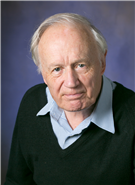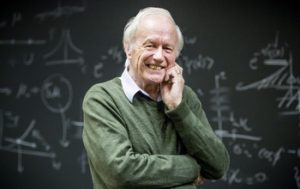Sir Anthony James Leggett is recognized as the world expert in the field of low-temperature physics. He received the 2003 Nobel Prize in Physics for his work on superfluidity, a phenomenon in which certain extremely cold liquid substances flow without any viscosity. These fluids can have several strange properties, including the ability to flow up the sides and out of the top of containers. Leggett was knighted in 2004 by Queen Elizabeth II for his contributions to physics.
Leggett was born in 1938 in Camberwell, South London. His parents were high-school teachers; his father taught physics, chemistry, and mathematics and his mother taught mathematics but later stopped teaching to take care of Leggett and his four siblings. When Leggett was eighteen months old, World War II broke out and his family was moved to a small village in Surrey. They returned after the war to their family home in Upper Northwood.
In 1954, Leggett had obtained a scholarship to Balliol College in Oxford where he studied the classics, philosophy, and ancient literature. However, before he left, his interest in mathematics was sparked when a retired priest in his school offered to teach him advanced mathematics.
This interest remained with him throughout his undergraduate years and eventually led him to apply for a second undergraduate degree in physics in 1958. After completing his degree in two years, Leggett decided to continue his postgraduate studies in physics. He completed his Ph.D. from the University of Oxford in 1964.
For his postdoctoral work, Leggett wanted to join a university which was famous for its research and was as different as possible from Oxford. The University of Illinois at Urbana-Champaign fit perfectly. Leggett joined the group of David Pines and soon became interested in the superfluid phase of liquid helium.
His fellowship extended beyond his postdoctoral years, allowing him to spend a year at Kyoto University in Japan. After his postdoctoral training, Leggett joined the University of Sussex in 1967 where he spent his time teaching undergraduates and working on problems in theoretical physics.
In the spring of 1982, Leggett received an offer from the University of Illinois, which he accepted. He worked on several theoretical problems including the low-temperature properties of gases and high-temperature superconductivity, a phenomenon in which certain materials have zero resistance when cooled below a certain temperature. For this work he received a Nobel Prize. Leggett has also held a position at the Institute for Quantum Computing in Waterloo, Canada from 2006-2016.
Leggett is a member of the National Academy of Sciences, the American Philosophical Society, and the American Academy of Arts and Sciences. He was elected a Fellow of the Royal Society in 1980, the American Physical Society in 1985, and the Institute of Physics, UK in 1998. He has also won several awards including the Maxwell Medal and Prize of the British Institute of Physics in 1975, the Eugene Feenberg Memorial Medal in 1999, and the 2002/2003 Wolf Foundation Prize for research on condensed forms of matter.
He currently works as a Chief Scientist at the Institute for Condensed Matter Theory at the University of Illinois.
- Loomis Laboratory: The central hallway of Loomis Lab contains reproductions of Leggett’s Nobel Prize. Directions: Enter through north or south entrances and walk straight. Display Case will be on the wall.
- Historical Marker – Outside Loomis Laboratory on the west side is a historical marker for Leggett’s work on superfluidity.
Dr. Leggett’s Faculty page – has more descriptions of his research
Dr. Leggett’s Nobel Prize Lecture – https://www.nobelprize.org/uploads/2018/06/leggett-lecture.pdf
Leggett, A. (n.d.) Anthony J. Leggett. Retrieved from https://physics.illinois.edu/people/directory/profile/aleggett
Anthony J. Leggett (2019). In NobelPrize.org. Retrieved from https://www.nobelprize.org/prizes/physics/2003/leggett/biographical/
Stauffer, L. B. Photo of Anthony Leggett. Retrieved from https://www.nsf.gov/discoveries/disc_images.jsp?cntn_id=191243&org=NSF
Tikkanen, A. (n.d.) Anthony J. Leggett: British Physicist. Retrieved from https://www.britannica.com/biography/Anthony-J-Leggett
Wikipedia contributors. (2019, March 27). Anthony James Leggett. In Wikipedia, The Free Encyclopedia. Retrieved from https://en.wikipedia.org/wiki/Anthony_James_Leggett


